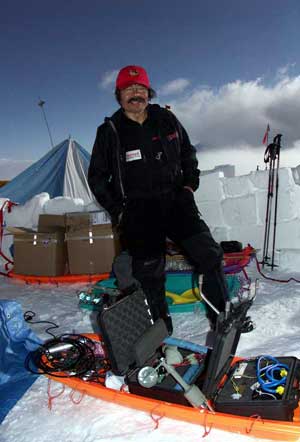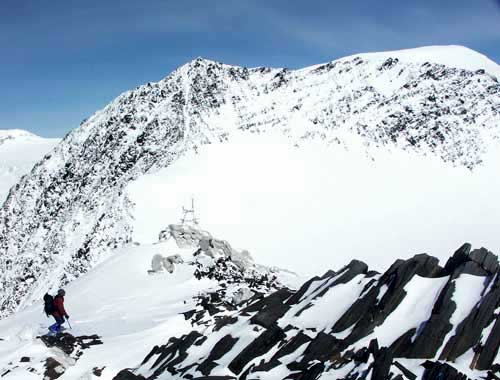 By Ned Rozell July 20, 2006
Okura had just reached the summit of Denali for the seventeenth straight year, information he only gave up when prodded. He wanted to talk about the repair of Alaska's highest weather station, which now informs me via the Web that the temperature at 18,733 feet on North America's highest peak is 3 degrees Fahrenheit. It's 66 degrees here at 450 feet in Fairbanks and 99 degrees at LaGuardia International Airport during an East Coast heat wave. Okura has been involved with the Denali weather station ever since he and a group of Japanese climbers in 1990 installed an aluminum tetrapod amid granite boulders a few steps off the West Buttress climbing route. In 1999, the International Arctic Research Center at the University of Alaska Fairbanks started maintaining the station in partnership with the National Park Service, and each year a group has climbed the mountain with the goal of fixing the station. The station breaks often because it sits so high in the atmosphere and absorbs such extreme weather. In January 2003, the station stopped transmitting after it recorded a 188-mile gust of wind. Wind is just one of the challenges facing a weather station that sits high enough that the jet stream sometimes dips down to blast it in midwinter. "Icing, winds, temperature, flying rocks, whatever, there's a lot that can go wrong up there," said Kevin Abnett, the founder of Polartronix. Abnett designed a radio telemetry system for the station that works on a tenth of the juice required to power a cellphone. The station transmits weather information to Cantwell, where a microwave transmitter relays the signal to UAF, where the information is posted on the Web at http://www.iarc.uaf.edu/mt_mckinley/. To repair the station this summer, a group of eight climbers from Japan and the International Arctic Research Center were on the mountain from June 8 to 27. The climbers followed the West Buttress route, the most popular snowpath up the mountain, and they all reached the summit after pausing for a few hours at the weather station site.
approaches the high-altitude weather station on Denali. Photo by Tohru Saito.
Saito has reached the summit after working on the station the last three years after failing to go beyond the station in the two years before that. "I totally deflate after the weather station," he said. Okura has received funding to continue maintaining the weather station on climbs for the next few years. He helped install the weather station in 1990 because he believes three of his countrymen disappeared there while attempting a winter climb in February 1989. They may have been blown off the mountain, he said, which also may have been the fate of Japanese adventurer Naomi Uemura, who vanished while attempting to climb the mountain solo in February 1984. This September, while the Denali weather station is hopefully still beaming information back to the Internet, Okura will attempt the summit of Manaslu in the Himalayas, which is more than one mile higher than Denali. Okura said the average age of his climbing team is 62. The man who stood on top of Denali for the seventeenth time this summer will be the youngster in the group, at 55.
Ned Rozell [nrozell@gi.alaska.edu] is a science writer at the institute. Publish A Letter on SitNews Read Letters/Opinions
|
||

